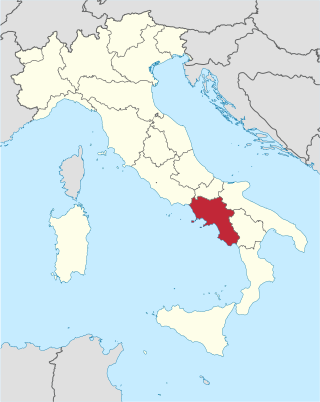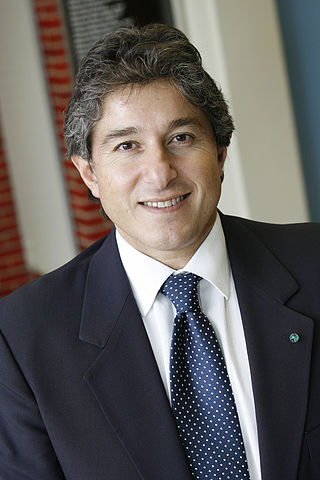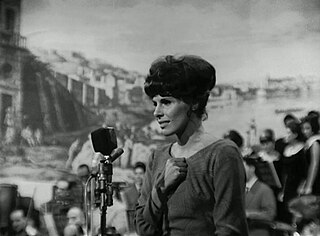
Campania is an administrative region of Italy; most of it is in the south-western portion of the Italian peninsula, but it also includes the small Phlegraean Islands and the island of Capri. The capital of the Campania region is Naples. As of 2018, the region had a population of around 5,820,000 people, making it Italy's third most populous region, and, with an area of 13,590 km2 (5,247 sq mi), its most densely populated region. Based on its GDP, Campania is also the most economically productive region in southern Italy and the 7th most productive in the whole country. Naples' urban area, which is in Campania, is the eighth most populous in the European Union. The region is home to 10 of the 58 UNESCO sites in Italy, including Pompeii and Herculaneum, the Royal Palace of Caserta, the Amalfi Coast and the Historic Centre of Naples. In addition, Campania's Mount Vesuvius is part of the UNESCO World Network of Biosphere Reserves.

Naples is the regional capital of Campania and the third-largest city of Italy, after Rome and Milan, with a population of 909,048 within the city's administrative limits as of 2022. Its province-level municipality is the third-most populous metropolitan city in Italy with a population of 3,115,320 residents, and its metropolitan area stretches beyond the boundaries of the city wall for approximately 20 miles.

The Kingdom of Naples, also known as the Kingdom of Sicily, was a state that ruled the part of the Italian Peninsula south of the Papal States between 1282 and 1816. It was established by the War of the Sicilian Vespers (1282–1302), when the island of Sicily revolted and was conquered by the Crown of Aragon, becoming a separate kingdom also called the Kingdom of Sicily. This left the Neapolitan mainland under the possession of Charles of Anjou. Later, two competing lines of the Angevin family competed for the Kingdom of Naples in the late 14th century, which resulted in the death of Joan I by Charles III of Naples. Charles' daughter Joanna II adopted King Alfonso V of Aragon as heir, who would then unite Naples into his Aragonese dominions in 1442.

Januarius, also known as Januarius I of Benevento, was Bishop of Benevento and is a martyr and saint of the Catholic Church and the Eastern Orthodox Church. While no contemporary sources on his life are preserved, later sources and legends claim that he died during the Great Persecution, which ended with Diocletian's retirement in 305.

Belisario Corenzio was a Greek-Italian painter, active in Venice and Naples. He is one of few Greek painters that did not belong to the Cretan Renaissance like his contemporaries of the time. He escaped the maniera greca completely. He adopted the Venetian style. Other similar Greek painters were Marco Basaiti, Ioannis Permeniates, Antonio Vassilacchi and El Greco. He was sometimes referred to as Il Greco. His teacher was prominent Venetian painter Tintoretto. In 1590, at age 32 Corenzio settled in Naples. Corenzio was influenced by Cavalier d'Arpino. He continued to flourish in the region. His apprentices included: Luigi Rodriguez, Andrea di Leone, Onofrio De Lione and Massimo Stanzione. Corenzio painted many frescos that survived today. Some of his works are in the Church of San Severino and Certosa di San Martino. His style resembles Caravaggio. An Italian legend in Naples exists involving Corenzio, Spanish painter Jusepe de Ribera, and Battistello Caracciolo. They were referred to as the Cabal of Naples. The three painters were rumored to have poisoned their competition for painting contracts. The rumors lack documented evidence. The three painters were very popular in Naples. Corenzio frescoed the Crypt that holds the remains of Matthew the Apostle at Salerno Cathedral and it depicts scenes from the Gospel of Matthew. Corenzio was one of the most celebrated fresco painters in Naples during his time. His drawings can be found all over the world namely at the Metropolitan Museum, Museo di Capodimonte and Louvre.

The University of Naples Federico II is a public university in Naples, Italy. Established in 1224, it is the oldest public or state university in the world. Noted for being the world's oldest public or state-funded university chartered by the head of a state and one of the world's ten oldest universities in continuous operation, it is also believed to be the oldest secular or non-sectarian state university in the world.

Giugliano in Campania, also known simply as Giugliano, is a city and comune in the Metropolitan City of Naples, Campania, Italy. A suburb of Naples, as of 2017, it had some 124,000 inhabitants, making it the most populated Italian city that is not a provincial capital.

The Naples–Salerno high-speed railway line is a link in the Italian high-speed rail network opened in June 2008. The 29-kilometre-long (18 mi) line is one of the new high-speed lines being built to strengthen rail transport system in Italy and in particular freight and passenger transport in Campania. The line is part of Corridor 1 of the European Union's Trans-European high-speed rail network, which connects Berlin and Palermo.

Nola is a town and a municipality in the Metropolitan City of Naples, Campania, southern Italy. It lies on the plain between Mount Vesuvius and the Apennines. It is traditionally credited as the diocese that introduced bells to Christian worship.
Vincenzo Russo was an Italian patriot, who was a leading supporter of the short-lived Parthenopean Republic. Captured by the Sanfedista forces, he was soon executed along with many other rebels of the Bourbon rule of Ferdinand IV of Naples.

The church of Santi Severino e Sossio and the annexed monastery are located on via Bartolommeo Capasso in Naples, Italy.

Vittorio De Marino, full name Vittorio Pietro Paolo Giovanni Battista Pasquale De Martino, was an Italian physician known for his compassion for the poor of Naples and later a priest of the Barnabite Order. He was declared venerable by Pope John Paul II on 12 December 1992.

Pasquale Simonetti, known as Pascalone 'e Nola, was an Italian criminal of the Camorra, a Mafia-type organisation in Naples and Campania in Italy.
Luigi Pasquarelli was an Italian sculptor. Was bos from Antonio and Antonia Lauria. Pasquarelli completed his studies in Naples. He gained acclaim in 1877 in Naples for a marble group depicting: Un episodio di Pompei. Among his other works are: Pescatore amalfitano; Piccola ciociara; Fruttivendola; Busto muliebre; some portraits, many bassorilievi and funereal monuments. At Turin, in 1880, he exhibited a statue depicting: Un venditore napoletano di frutta. Minutes of a meeting of the council of Naples from 1872, document a trip to Brazil.

Antonio Giordano is an oncologist, pathologist, geneticist, researcher, professor and writer. A naturalized American from Italy, he is the Director of the Sbarro Institute for Cancer Research and Molecular Medicine in Philadelphia, and a professor of Anatomy and Pathological Histology at the Department of Medical Biotechnology of the University of Siena. He has discovered some key factors in the regulation of the cell cycle and of mechanisms linked to the onset of tumors. In particular, he distinguished himself for having isolated the tumor suppressor gene, the RB2/p130, subsequently demonstrating how the same gene, introduced through a retrovirus in some animal models, is able to reduce the growth of tumors. In addition to his career as a researcher he also distills science for a popular audience, mostly concerning cancer risk in the Campania Region, and its relation to toxic waste.

The Festival della Canzone Napoletana, commonly known as the Festival di Napoli, is a Neapolitan song contest. The first edition was held in 1952 and the last in 2004. From 1952 to 1970 the show was broadcast on RAI and from 1998 to 2004, in a differently spirited version, by Rete 4.

Paolo Panceri was an Italian naturalist. Panceri graduated in medicine at the University of Pavia where he began his research. In 1861 he took the Chair of Comparative anatomy at the University of Naples, where he directed the Zoology Museum. Panceri was cautious about the scientific validity of evolutionary theories but was instrumental in the foundation of the Stazione Zoologica Anton Dohrn. His findings on the bioluminescence of marine invertebrates and studies of Amphioxus led to fame in Italy and abroad. In 1874 he sold his books and scientific papers to Biblioteca Universitaria di Napoli to pay for an expedition to Egypt. They constitute an example of a nineteenth-century library specializing in the natural sciences and comparative anatomy. His students in Naples include Carlo Emery, Leopoldo Maggi and Antonio della Valle. He died aged 44.

Marco De Gregorio was an Italian painter, who would form part of the School of Resina, painting works that spanned the spectrum from historical to genre topics.

Antonio Mario Timoleone Savaresi (1773–1830) was a Neapolitan military physician. He served in the French armies in Italy, Egypt and on Martinique and later became the physician-in-chief of the armies of the Kingdom of Naples as well as a renowned scientist.

The history of cinema in Naples begins at the end of the 19th century and over time it has recorded cinematographic works, production houses and notable filmmakers. Over the decades, the Neapolitan capital has also been used as a film set for many works, over 600 according to the Internet Movie Database, the first of which would be Panorama of Naples Harbor from 1901.


















